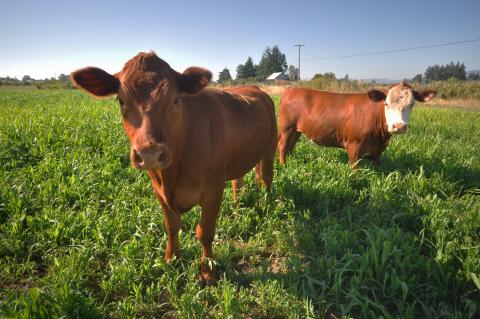What is agricultural risk?
Risk is always a part of farming businesses and agricultural production. Weather, environmental pressures, yields, prices, policies, global markets, and other factors affect farm income, management, and production. Generally, there are five types of risk: production risk, price or market risk, financial risk, institutional risk, and human/personal risk. While producers employ a number of strategies to reduce and cope with these risks, the federal government also plays an important role in reducing producers’ exposure to these different sources of risk. A variety of risk management programs are available to help crop and livestock producers mitigate losses to their income due to yield and price risk. Read more on risk management from the Economic Research Service. The table below summarizes select commodity support programs.
| Payment trigger | Crops | Livestock and dairy |
|---|---|---|
| Price | Price Loss Coverage; Loan Deficiency Payments/Marketing Assistance Loans; Sugar Price Support | Livestock Risk Protection (LRP) |
| Yield or physical loss |
Tree Assistance Program; Non-insured Crop Disaster Assistance Program
Yield protection insurance policies; Supplement Coverage Option (SCO); Livestock Forage |
Livestock Indemnity Program (LIP); Livestock Forage Disaster Program (LFP); Emergency Assistance for Livestock, Honey Bees, and Farm-Raised Fish (ELAP); Pasture, Rangeland, and Forage (PRF) |
| Revenue | Agriculture Risk Coverage; Revenue protection insurance policies; Stacked Income Protection Plan (STAX); Supplemental Coverage Option (SCO) | |
| Margin | Margin Protection insurance for corn, rice, soybeans, and wheat pilot programs | Margin Protection Program for Dairy (MPP-Dairy); Livestock Gross Margin Insurance |
Recovery: Disaster assistance
USDA provides a suite of disaster assistance programs to help offset losses and recover from the impacts of natural disasters and market volatility. For example, Farm Service Agency (FSA) provides post-disaster financial assistance to the animal and livestock sectors (see example programs to the right).

Emergency Assistance for Livestock, Honeybees, and Farm-Raised Fish (ELAP): Provides financial assistance to eligible producers for livestock, honeybee, and farm-raised fish losses, including death, feed, grazing, and associated transport costs, due to disease and certain adverse weather events or loss conditions.
Livestock Forage Disaster Program (LFP): Provides compensation to eligible livestock producers who have suffered grazing losses on land that is native or improved pastureland with permanent vegetative cover or is planted specifically for grazing.
Livestock Indemnity Program (LIP): Provides benefits to livestock owners and contract growers who experience livestock deaths in excess of normal mortality caused by specific adverse weather, disease, or animal attacks.
Protection: Crop insurance
Crop insurance provides an additional “safety net” for farmers for when yields fall below a specified level. The Risk Management Agency (RMA) manages the FCIP to provide innovative crop insurance products to America’s farmers and ranchers.
Crop insurance policies are sold and serviced by approved insurance providers. The program is designed to protect producers from the risks associated with adverse weather and climate-driven events, such as droughts, excess rainfall, hail, and floods, weather-related plant diseases and plant infestations, and declines in commodity prices.
Our Southern Plains Podcast visited with Francie Tolle, Director of the Product Administration and Standards Division with RMA. Listen how RMA is helping producers manage risk among other topics!
Crop insurance in the Southern Plains
In Kansas, the top three crops insured by acreage are wheat, corn, and soybeans totaling over 16 million acres. For dollar liability programs, dairy revenue protection had a total liability of $236.6 million followed by an $82.6 million liability for feeder cattle in livestock risk protection.
Wheat, soybeans, and cotton are the top three insured crops by acreage in Oklahoma; however, wheat has 3.1 million insured acres almost six times as many insured acers as soybeans (511k acres). Feeder cattle have a $144.9m liability.
In Texas, cotton, wheat, and corn are the top three crops insured by acreage totaling over 12.5m acres. Under dollar liability programs, citrus trees have a $176m liability followed by $81.2m for feeder cattle and $72.4m for nursery plants.
These statistics demonstrate the importance of RMA and its programs as risk management tools for the region’s agricultural and livestock production.

